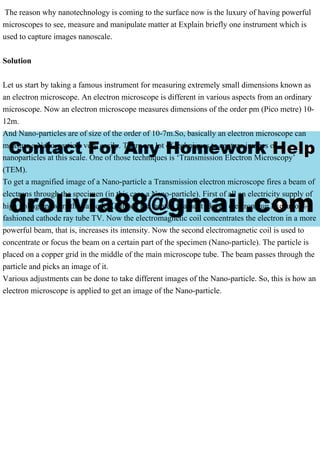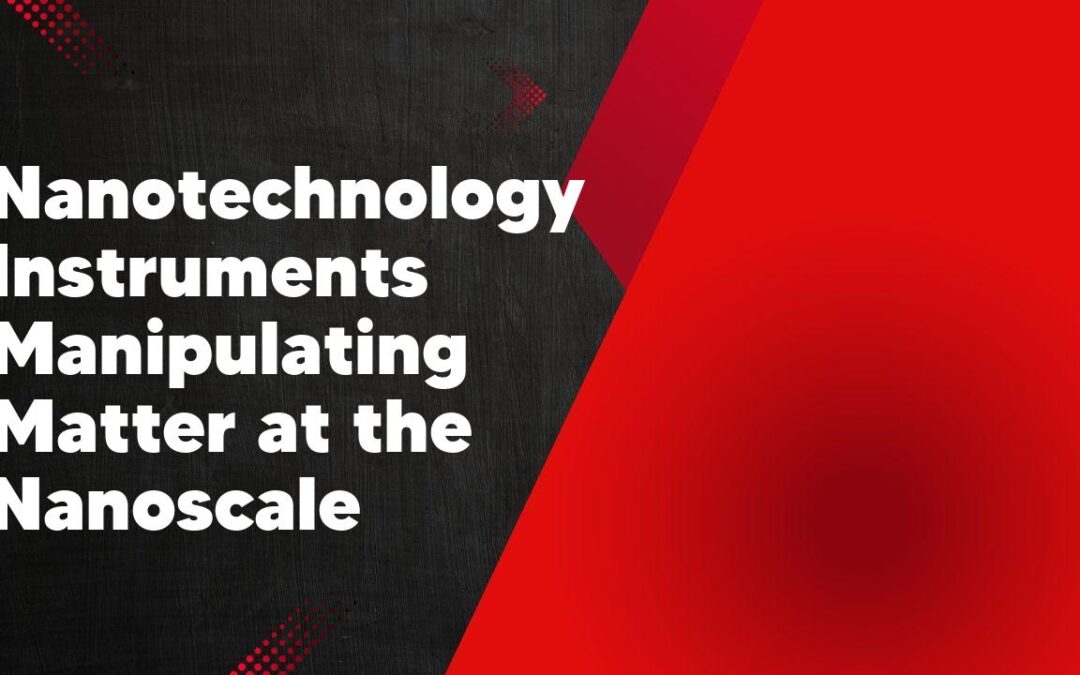Nanotechnology has revolutionized various fields by allowing scientists and researchers to manipulate matter at an incredibly small scale. Nanotechnology instruments play a crucial role in these advancements, enabling precise control and measurement at the nanoscale. This article explores the different types of instruments used in nanotechnology and their applications in various industries.
1. Introduction to Nanotechnology Instruments
Nanotechnology Instruments have revolutionized the field of science and technology, allowing us to observe and manipulate matter at the atomic and molecular levels. As a scientist, I am constantly amazed at the capabilities of these instruments and the vast opportunities they present for research and discovery. With nanotechnology instruments, we can now delve into the world of nanoscale materials and structures, unlocking their secrets and manipulating them to create new and innovative technologies. Whether it’s studying the behavior of nanoparticles or designing nanosensors for medical diagnostics, nanotechnology instruments have certainly opened up a whole new realm of possibilities. In this article, I will introduce you to some of the most commonly used nanotechnology instruments and explain their functionalities in greater detail.
2. The Role of Nanotechnology in Manipulating Matter

Nanotechnology has revolutionized the way scientists manipulate matter at the atomic and molecular levels. As a researcher in this field, I am fascinated by the endless possibilities that nanotechnology offers. It allows us to engineer materials with enhanced properties, such as increased strength or conductivity, by controlling their structure at the nanoscale. This level of precision has immense potential in various industries, from electronics to medicine. For instance, nanotechnology has enabled the development of faster and more powerful computer chips and has opened new avenues for targeted drug delivery in cancer treatment. The ability to manipulate matter at such a small scale has truly transformed our understanding and utilization of materials.
3. Types of Nanotechnology Instruments
Nanotechnology instruments play a crucial role in the field of nanotechnology research and development. There are several types of instruments that are used to manipulate and study materials at the nanoscale. One type of instrument is the scanning tunneling microscope (STM) which allows scientists to visualize atoms on a surface by scanning a fine-tipped probe over the material. Another important instrument is the atomic force microscope (AFM) which is used to measure the forces between atoms and surfaces. Additionally, nanoparticle analyzers are used to characterize and analyze nanoparticles, while nanomanipulators are used to precisely position and manipulate nanoscale objects. These instruments are essential for advancing our understanding and application of nanotechnology in various fields such as medicine, electronics, and materials science.
4. Applications of Nanotechnology Instruments
As a scientist working in the field of nanotechnology, I am constantly amazed by the numerous applications that nanotechnology instruments have. Nanotechnology has revolutionized industries such as electronics, medicine, and energy. In the electronics industry, nanotechnology instruments have enabled the creation of smaller and more efficient devices, such as nanoscale transistors and memory cells. These instruments have also played a vital role in enhancing the capabilities of medical devices, enabling targeted drug delivery and the development of nanosensors for early disease detection. Furthermore, nanotechnology instruments have the potential to greatly improve energy efficiency by enabling the development of more efficient solar panels, energy storage devices, and lightweight materials for transportation. The applications of nanotechnology instruments are endless, and I am excited to continue exploring their possibilities in advancing various fields.
5. Challenges and Limitations in Nanoscale Manipulation
As a researcher in the field of nanoscale manipulation, I have encountered numerous challenges and limitations in my work. One of the major challenges is the precise control of nanoscale objects. Due to their incredibly small sizes, it is extremely difficult to manipulate them with traditional tools. The tiniest disturbance or imprecise movement can cause a complete failure in the desired manipulation. Additionally, we often face limitations in terms of the available technology. The tools and equipment required for nanoscale manipulation are highly specialized and expensive, making them inaccessible for many researchers. Furthermore, the lack of comprehensive understanding of nanoscale phenomena adds another layer of complexity to our work. Despite these challenges and limitations, I remain optimistic and determined to overcome them in pursuit of groundbreaking discoveries in the field of nanoscale manipulation.
6. Future Prospects of Nanotechnology Instruments
In my opinion, the future prospects of nanotechnology instruments are incredibly promising. As we continue to advance our understanding of nanoscale materials and their properties, we can expect to see significant breakthroughs in various fields. Nanotechnology instruments have the potential to revolutionize medicine, electronics, energy, and countless other industries. For instance, in the medical field, nanoscale devices can be used for targeted drug delivery, early disease detection, and more precise surgical procedures. In electronics, nanotechnology can enable the development of faster and smaller devices with enhanced performance. Additionally, the energy sector can benefit from the use of nanotechnology to improve efficiency and storage capacities of batteries and solar cells. Overall, the future of nanotechnology instruments holds immense possibilities for solving complex challenges and improving our quality of life.
Conclusion
In conclusion, nanotechnology instruments have revolutionized the way we manipulate matter at the nanoscale. These instruments allow scientists and researchers to study and control materials at the atomic and molecular level, leading to advancements in various fields such as medicine, electronics, and energy. As the field of nanotechnology continues to grow, it is expected that these instruments will play a pivotal role in shaping the future of technology and scientific discovery.
What is nanotechnology?
Nanotechnology is the science, engineering, and application of materials and devices with structures and components that have a size of 1 to 100 nanometers.
What are nanotechnology instruments?
Nanotechnology instruments are tools and devices specifically designed and used for manipulating matter at the nanoscale, which is a billionth of a meter in size.
How do nanotechnology instruments work?
Nanotechnology instruments utilize various techniques such as scanning probe microscopy, electron microscopy, and molecular manipulation to understand, manipulate, and create nanoscale objects and structures.
What are the applications of nanotechnology instruments?
Nanotechnology instruments are widely used in various industries including electronics, medicine, energy, and materials science. They are used for nanofabrication, nanocharacterization, and nanomanipulation processes.
What are the benefits of nanotechnology instruments?
Nanotechnology instruments allow for precise control and manipulation of materials at the atomic and molecular level. This enables researchers to develop new materials with enhanced properties, improve existing technologies, and explore new areas of science and engineering.
Are nanotechnology instruments safe to use?
Nanotechnology instruments are generally safe when used properly and with proper safety precautions. However, as with any technology, it is important to follow safety guidelines and protocols to minimize any potential risks and ensure safe handling and operation of these instruments.

